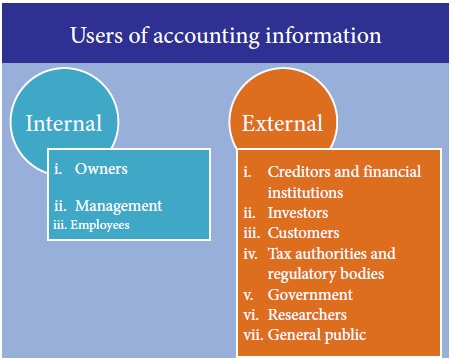Accountancy - Users of Accounting information | 11th Accountancy : Chapter 1 : Introduction to Accounting
Chapter: 11th Accountancy : Chapter 1 : Introduction to Accounting
Users of Accounting information
Users of Accounting information
There are several persons who need the accounting
information for various purposes. They can be classified into two:
A. Internal users and
B. External users

A) Internal Users
The internal users are owners, management and
employees who are within the organisation.
(i) Owners
The owners of a business provide capital to be used
in the business. They are interested to know whether the business has earned
profit or not during a particular period and also its financial position on a
particular date. They want accounting reports in order to have an appraisal of
performance and also for an assessment of future prospects to ensure that they
will get their expected returns from the business and get back their capital
safely.
(ii) Management
Accounting data are the basis for most of the
decisions made by the management. The trends in sales and purchases,
relationship of expenses to the sales, efficiency of employees, comparative
profitability of different departments, capital structure and solvency position
are some of the vital data required by management for planning and controlling
the business operations. Financial statements and other reports prepared under
financial accounting provide this information to the management.
(iii) Employees
The employees
are interested in the profit earning capacity of the business which will affect
their remuneration, working conditions and retirement benefits and stability
and growth of the enterprise.
B) External users
External
users are the persons who are outside the organisation but make use of
accounting information for their purposes. They are:
(i) Creditors and financial institutions
Suppliers of
goods and services, commercial banks, public deposit holders and
debentureholders are included in this category. They are interested in knowing
the liquidity position and repaying capacity of the business to ensure the
safety of getting the amount due to them or interest and the principal amount.
(ii) Investors
Persons who
are interested in investing their funds in an organisation should know about
the financial condition of a business unit while making their investment
decisions. They are more concerned about future earnings and risk bearing capacity
of the organisation which will affect the return to the investors.
(iii) Customers
Customers who
buy and use the products and services of business enterprises are interested in
knowing the details of the products and the prices charged to them. They are
interested in knowing the stability and profitability of an enterprise to
ensure continued supply of the products or services by the enterprise.
(iv) Tax authorities and other regulatory bodies
Accounting
information helps the tax authorities in computing income tax and taxes on
goods and services and other taxes to be collected from business units. Other
regulatory bodies also ![]() require information about revenues, expenses and other financial aspects
of business to ensure that the enterprises comply with statutory requirements.
require information about revenues, expenses and other financial aspects
of business to ensure that the enterprises comply with statutory requirements.
(v) Government
The scarce
resources of the country are used by business enterprises. Information about
performance of business units in different industries helps the government in
policy formulation for development of trade and industry, allocation of scarce
resources, grant of subsidy, etc. Government also administers prices of certain
commodities. In such cases, government agencies have to ensure that the
guidelines for pricing are followed.
(vi) Researchers
Researchers
to carry out their research can use accounting information and make use of the
published financial statements for analysis and evaluation.
(vii) General public
From
accounting information, the general public at large can get a view of the
earning capacity and stability of the enterprise as well as the social
responsibility measures undertaken by the enterprise particularly in its area
of operation and also the employment opportunities provided to the local
people.

Related Topics